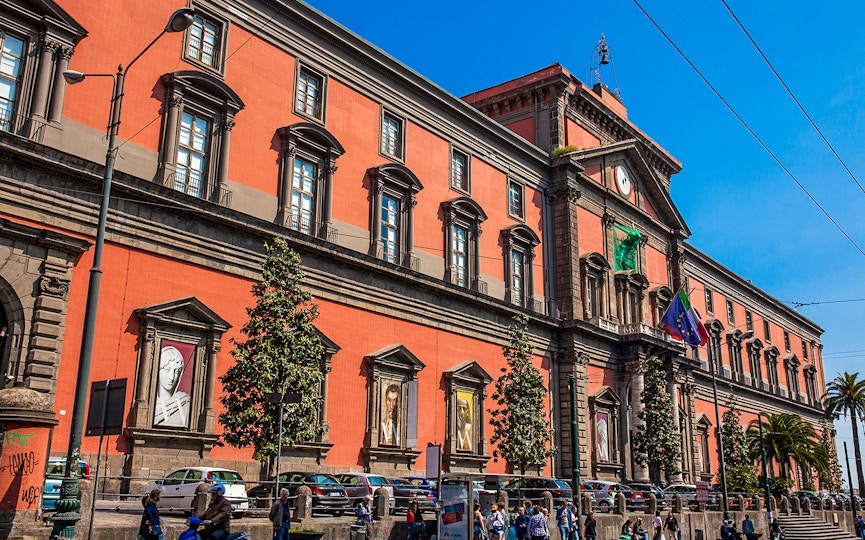The National Archaeological Museum in Naples houses an expansive ancient Egyptian collection, making it one of the largest in the world. Highlights include the Naoforo Farnese, Charta Borgiana and The Lady of Naples.

- Pompeii Tickets & Tours
- Herculaneum Tickets
- Mount Vesuvius
- Naples Underground
- Museo Di Capodimonte
- Villa Pignatelli
- Royal Palace of Naples
- Certosa di San Martino
- Catacombs of San Gennaro, Naples Tickets
- Città della Scienza
- Capri Boat Tours
- Bourbon Tunnel
- Maradona Tours
- Artecard Naples City Pass
- Veiled Christ
- Alibus Airport Transfers
See the past preserved: History and highlights of the Naples National Archaeological Museum
The National Archaeological Museum of Naples, also known as MANN (Museo Archeologico Nazionale di Napoli), is home to a vast collection of Greek and Roman antiquities, especially artifacts from Pompeii and Herculaneum.
Quick Information
RECOMMENDED DURATION
3 hours
Timings
09:00–19:30
VISITORS PER YEAR
450000
TICKETS
From € 34.20
NUMBER OF ENTRANCES
3
EXPECTED WAIT TIME - STANDARD
0-30 mins (Peak), 0-30 mins (Off Peak)
EXPECTED WAIT TIME - SKIP THE LINE
0-30 mins (Peak), 0-30 mins (Off Peak)
Did you know?
The National Archeological Museum of Naples has a Secret Room, or Gabinetto Segreto, which contains erotic artifacts and sculptures from Pompeii and Herculaneum, capturing their preoccupation with sensual pursuits.
Between 1616 and 1777, the museum was the seat of the University of Naples.
In the 18th century, the museum was also used as army barracks by the Bourbon family and a dumping ground for the looted collections from Pompeii and Herculaneum.
Buy your Naples National Archaeological Museum tickets
What to see at Naples National Archaeological Museum?
Egyptian Collection
History of the Naples National Archaeological Museum

17th and 18th centuries
From 1616-1777, the building that would later be known as the National Archaeological Museum initially served as the seat of the University of Naples and a cavalry barracks as well. in the 18th century, Charles III of Bourbon established the museum, originally known as the Royal Bourbon Museum, driven by his interest in art and culture. He aimed to house antiquities inherited from his mother, Elisabetta Farnese, and the treasures from the recently discovered cities of Herculaneum and Pompeii, both devastated by the eruption of Mount Vesuvius.
Later, Ferdinand VI, Charles III's son, further enriched the museum's collection by curating Elisabetta Farnese's Roman artifacts and Vesuvian findings within the museum. During the French domination in Naples, the first facilities for the museum were organized.

19th century to present day
Ferdinand VI exerted significant influence in the turn of events that altered the now-museum's destiny. Despite protestations from the Pope, he moved the Farnese Collection from Rome to Naples, incorporating it to the museum then called Real Museo Borbonico.
Following the unification of Italy in 1860, the museum was officially named the National Archaeological Museum of Naples, marking a new chapter in its history, and was further enhanced by private collections from Caroline Murat and the library of Count Eduardo Lucchesi Palli.
Who built the Naples Museum?

The National Archaeological Museum of Naples, originally known as the Real Museo Borbonico, was established by Charles III of Bourbon, who was the King of Naples in the late 18th century. Charles III played a crucial role in founding the museum, driven by his interest in art and culture. His vision was two-fold:
- To house a collection of antiquities inherited from his mother, Elisabetta Farnese, and
- To showcase the extraordinary treasures discovered in the ancient cities of Herculaneum and Pompeii, which had been devastated by the eruption of Mount Vesuvius.
Frequently asked questions about the National Archaeological Museum in Naples
The National Archaeological Museum of Naples was established to showcase ancient artifacts and archaeological treasures from the Vesuvian region. Today, it is a renowned cultural institution in Italy, preserving and displaying a vast collection of coins, inscriptions and sculptures, along with the Renaissance-era collections of Alexander Farnese and his successors.
You can either purchase your Naples National Archaeological Museum tickets online on-spot, although opting for the latter method might mean waiting in long queues, particularly during peak tourist seasons. As a result, it is recommended to purchase tickets in advance online. This allows you to select a specific date and time slot for your visit, and also give you the option of booking guided tours, combo tours, etc.
Some unmissable works include the detailed and colorful Alexander Mosaic, the colossal Farnese Hercules, and the Secret Cabinet's explicit art salvaged from Herculaneum and Pompeii, among others.
The Naples National Archaeological Museums is known for its array of ancient treasures and collections that provide a glimpse into Roman, Greek and even Egyptian historic life. It has artefacts from Egypt as well as artifacts from Pompeii, Herculaneum, and other cities buried by the explosion of Mount Vesuvius.
Under the Bourbon King Charles III, the museum opened in 1777. After the unification of Italy in 1860, the museum was nationalized and renamed the National Archaeological Museum of Naples.









